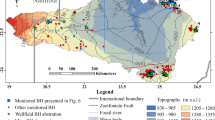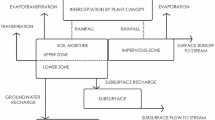Abstract
A Decision Support System has been set up as the result of a fruitful cooperation between several public and research institutions in the framework of a large cooperation program. The DSS aims to compare spatially and temporally sectorial water demands of the Haouz-Mejjate plain (Morocco) in regard to available surface and groundwater resources. It is composed of a tool for satellite estimation of Agricultural Water Demand (SAMIR), a tool for integrated water resources planning (WEAP) and a groundwater model (MODFLOW) each of them relying on a common Geographical Information System not described here. The DSS is operating on a monthly time scale. Agricultural water demand accounts for about 80 % of the total demand. In areas where groundwater abstraction is difficult to quantify by direct methods, multitemporal remote sensing associated to the FAO methodology is a simple and efficient alternative to estimate Evapotranspiration (ET). In this work, a monthly estimate of ET from irrigated areas is derived from freely available MODIS NDVI for the 2001–2009 period. An important part of the paper deals with the validation of these estimates with eddy covariance flux measurements installed on different irrigated crops of the region. Results are satisfactory with a minus 6.5 % error per year on the monthly time scale. This preprocessing allows to dichotomize irrigated versus non-irrigated areas, and then, to estimate groundwater abstraction in subareas distinguishing by their operating modes: traditional, dam or privately irrigated. A dynamic linkage between MODFLOW and WEAP transfers the results of one model as input data to the other. The model restitutes both spatial and temporal variations in head charges and allows the calculation of the ground water balance. After calibration, piezometric validation is acceptable for the majority of the 21 head control points.












Similar content being viewed by others
Abbreviations
- ET:
-
Evapotranspiration
- Eta:
-
Actual Evapotranspiration
- ET0:
-
Reference Evapotranspiration
- Fc:
-
Fraction Cover of vegetation
- Kc:
-
Crop Coefficient
- Kcb:
-
Basal Crop Coefficient
- NDVI:
-
Normalized Difference Vegetation Index
- RS:
-
Remote Sensing
- VI:
-
Vegetation Index
References
Abourida A, Simonneaux V, Errouane S, Berjamy B, Sghir F (2009) Estimation des volumes d'eau pompés dans la nappe pour l'irrigation (Plaine du Haouz, Marrakech, Maroc). Comparaison d'une méthode statistique et d'une méthode basée sur l'utilisation de données de télédétection. Revue des sciences de l'eau / Journal of Water Science, vol. 22, n° 1, p. 1–13.
Allen R, Pereira L, Raes D, Smith M (1998) Guideline for computing crop water requirements (Vol. Irrigation and Drainage Paper n°56). FAO.
Al-Omari A, Al-Quraan S, Al-Salihi A, Abdulla F (2009) A water management support system for Amman Zarqa Basin in Jordan. Water Resour Manag 23:3165–3189. doi:10.1007/s11269-009-9428-z
Assaf H, Van Beek E, Borden C, Gijsbers P, Jolma A (2008) Chapter thirteen generic simulation models for facilitating stakeholder involvement in water resources planning and management: a comparison, evaluation, and identification of future needs. In: Jakeman AVAJ (ed) Environmental Modelling, Software and Decision Support, Elsevier
Belghiti M (2008) L'agriculture irriguée au Maroc: Enjeux et marges de progrès. Revue HTE (139)
Bernet G, Prost J (1975) Le Haouz de Marrakech et le bassin du Mejjate. Ressources en Eau du Maroc, Tome 2. Rabat, Maroc: Notes et Mémoires du Service Géologique, n° 231
Boudhar A, Duchemin B, Hanich L, Jarlan L, Chaponnière A, Maisongrande P et al (2010) Long-term analysis of snow-covered area in the Moroccan High-Atlas through remote sensing. Int J Appl Earth Obs Geoinf 12:S109–S115. doi:10.1016/j.jag.2009.09.008
Bzioui M (2004) Rapport national 2004 sur les ressources en eau au Maroc. UN Water Africa.
Castaño S, Sanz D, Gómez-Alday J (2010) Methodology for quantifying groundwater abstractions for agriculture via remote sensing and GIS. Water Resour Manag 24–4:795–814. doi:10.1007/s11269-009-9473-7
Chehbouni A, Escadafal R et al (2008) An integrated modelling and remote sensing approach for hydrological study in arid and semi-arid regions: the SUDMED Programme. 2nd International Symposium on Recent Advances in Quantitative Remote Sensing. 29:478–423. Torrent, sp: Taylor & Francis
Courault D, Seguin B, Olioso A (2005) Review on estimation of evapotranspiration, from remote sensing data: From empirical to numerical modeling approaches. Irrigat Drain Syst (79-3-4), 223–249. doi:10.1007/s10795-005-5186-0
Debbi F (2004) Profil Environnemental de Marrakech, Agenda 21. Royaume du Maroc - PNUD
Droubi A (2008) Development and application of a decision support system (DSS) for water resources management in Zabadani Basin (Syria) and Berrechid Basin (Morocco). Damascus
Duchemin B, Hadria R, Er Raki S, Boulet G, Maisongrande P, Chehbouni A, Ezzahar J, Hoedjes J, Kharrou M, Khabba S, Mougenot B, Olioso A, Rodriguez J, Simonneaux V (2006) Monitoring wheat phenology and irrigation in Center of Morocco: on the use of relationship between evapotranspiration, crops coefficients, leaf area index and remotely–sensed vegetation indices. Agr Water Manag 79–1:1–27. doi:10.1016/j.agwat.2005.02.013
Er Raki S, Chehbouni A, Guemouria N, Duchemin B, Ezzahar J, Hadria R (2007) Combining FAO-56 model and ground-based remote sensing to estimate water consumptions of wheat crops in a semi-arid region. Agr Water Manag 87–1:41–54. doi:10.1016/j.agwat.2006.02.004
European Environment Agency (2006) The thematic accuracy of previous Corine land cover 2000. Assessment using LUCAS land use/cover area frame statistical survey. Retrieved 06 01, 2011, from http://reports.eea.europa.eu/technical_report_2006_7/en
Ezzahar J, Chehbouni A, Hoedjes J, Er Raki A, Chehbouni Ah, Boulet G, Bonnefond J, De Bruin H (2007) The use of the scintillation technique for monitoring seasonal water consumption of olive orchards in a semi arid region. Agr Water Manag 89–3:173–184. doi:10.1016/j.agwat.2006.12.015
FAO (2003) Review of world water resources by country (Vol. Water Reports 23)
FAO (2011) Aquastat Morocco. Retrieved from http://www.fao.org/nr/water/aquastat
Höllermann B, Giertz S, Diekkrüger B (2010) Benin 2025—balancing futurewater availability and demand using the WEAP ‘water evaluation and planning’ system. Water Resour Manag 24:3591–3613. doi:10.1007/s11269-010-9622-z
Hua L, Raupach M, McVicar T (2001) Decomposition of vegetation cover into woody and herbaceous components using AVHRR NDVI time series. CSIRO Land and Water, 35–01
Huete A, Didan K, Yin Y (2002) http://tbrs.arizona.edu/cdrom/VI_Intro/VI_MOD_VI_Prod.html. Retrieved from Terrestrial Biophysics and Remote Sensing Lab
Johannes M (2004) Modelling of the water balances in the Río Turbio aquifer. Wageningen University, Mexico
Justice C, Townshend J, Vermote E, Masuoka E, Wolfe R, Saleous N, Roy D, Morisette J (2002) An overview of MODIS Land data processing and product status. Remote Sensing of Environment , 83-1-2:3–15, doi:10.1016/S0034-4257(02)00084-6
Kabbaj A, Zeryouhi I, Pointet T (1979) Alimentation en eau de la ville de Marrakech: projet à court, moyen et long terme. Influences sur la nappe. Effects of Urbanization and Industraialization on the Hydrological Regime and on Water Quality. IAHS, Amsterdam
Margat J, Vallée D (1997) Démographie en Méditéranéee. Options Méditerranéenne. 31. CIHEAM.
Masson V, Champeaux J, Chauvin N, Meriguet C, Lacaze R (2003) A global database of land surface parameters at 1-km resolution in meteorological and climate models. J Climate 16–9:1261–1282
McDonald M, Harbaugh A (1988) A modular three dimensional finite difference ground-water flow model. Techniques of Water-Resources Investigations, Book 6. U.S. Geological Survey
McKinney D (2004) International survey of decision support systems for integrated water management. Bucharest, Romania: IRG PROJECT N° 1673-000
Mobin-ud-Din A, Bastiaanssen W, Feddes R (2005) A new technique to estimate net groundwater use across large irrigated areas by combining remote sensing and water balance approaches. Hydrogeol J 13(5–6):653–664. doi:10.1007/s10040-004-0394-5
Mutiga J, Mavengano S, Zhongbo S, Woldai T, Becht R (2010) Water allocation as a planning tool to minimise water use conflicts in the upper Ewaso Ng’iro North Basin, Kenya. Water Resour Manag 24–14:3939–3959. doi:10.1007/s11269-010-9641-9
Perera B, James B, Kularathna M (2005) Computer software tool REALM for sustainable water allocation and management. J Environ Manage 77–4:291–300. doi:10.1016/j.jenvman.2005.06.014
Rijsberman FR (2006) Water scarcity: fact or fiction? Agr Water Manag 80(1–3):5–22. doi:10.1016/j.agwat.2005.07.001
Sieber J, Purkey D (2011) WEAP user guide, http://www.weap21.org
Simonneaux V, Duchemin B, Chehbouni Ag, Cherkaoui M, Kharrou M (2007a) SAMIR, a tool for evapotranspiration assesment using remote sensing. 2nd International Symposium on Recent Advances in Quantitative Remote Sensing. 29: 597–601, Torrent, sp: Taylor & Francis.
Simonneaux V, Duchemin B, Helson D, Er-Raki S, Olioso A, Chehbouni Ag (2007b) The use of high-resolution image time series for crop classification and evapotranspiration estimate over an irrigated area in central Morocco. Int J Rem Sens 29–1:95–116. doi:10.1080/01431160701250390
Acknowledgment
This study was realized within the framework of the Joint International Laboratory TREMA, AGIRE project and ACSAD/BGR cooperation. The Tensift Basin Agency (Agence de Bassin Hydraulique du Tensift), which is a stakeholder in the two projects, played a key role in joining stakeholders. TREMA ‘Remote sensing and water resources in semi-arid environment’ involves the collaboration of CESBIO (Centre d’Etudes Spatiales de la Biosphère, Toulouse, France) the Cadi Ayyad University, Marrakech, Morocco, the Agriculture Office (Office de Mise en Valeur Agricole), thanks to the financial support of IRD (Institut de Recherche pour le Développement, France). AGIRE (Program to support the integrated management of water resources) involves the Ministry of Water and the Environment of the Kingdom of Morocco, the German International Cooperation (GIZ) and four Moroccan Basin Agencies. We are very grateful with each of these institutions for sharing their data and experience in this project. The Arab Center for the Studies of Arid Zones and Dry Lands (ACSAD) and the Federal Institute for Geosciences and Natural Resources, Germany (BGR) were the igniters of the WEAP-MODFLOW modeling through several workshops. Thanks to the Federal Institute for Geosciences and Natural Resources and Jack Sieber (SEI) for their technical support on WEAP. This study was also financially supported by Resamed project (Aquifer Recharge in the Mediterranean Area). We are grateful to the CNES (Centre National d’Etudes Spatiales, France) for its financial support during this work and for providing SPOT/LANDSAT images and facilitating the import of scientific equipment, the DMN (Direction de la Météorologie National, Morocco) for providing us with the outputs of the ALADIN model. Final thanks to Ian Timms for correcting the English version of the manuscript.
Author information
Authors and Affiliations
Corresponding author
Rights and permissions
About this article
Cite this article
Le Page, M., Berjamy, B., Fakir, Y. et al. An Integrated DSS for Groundwater Management Based on Remote Sensing. The Case of a Semi-arid Aquifer in Morocco. Water Resour Manage 26, 3209–3230 (2012). https://doi.org/10.1007/s11269-012-0068-3
Received:
Accepted:
Published:
Issue Date:
DOI: https://doi.org/10.1007/s11269-012-0068-3




